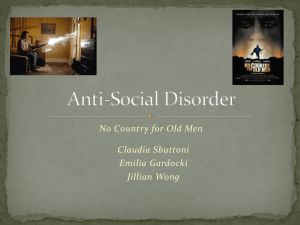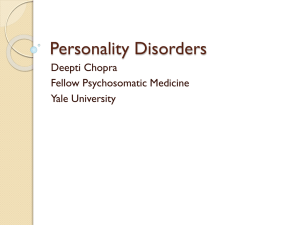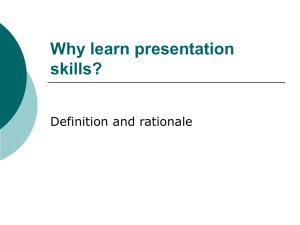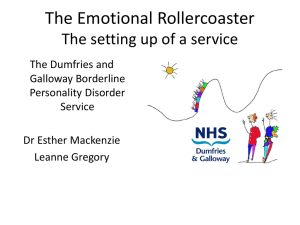Personality Disorders - Wales Counseling Center,PLLC
advertisement
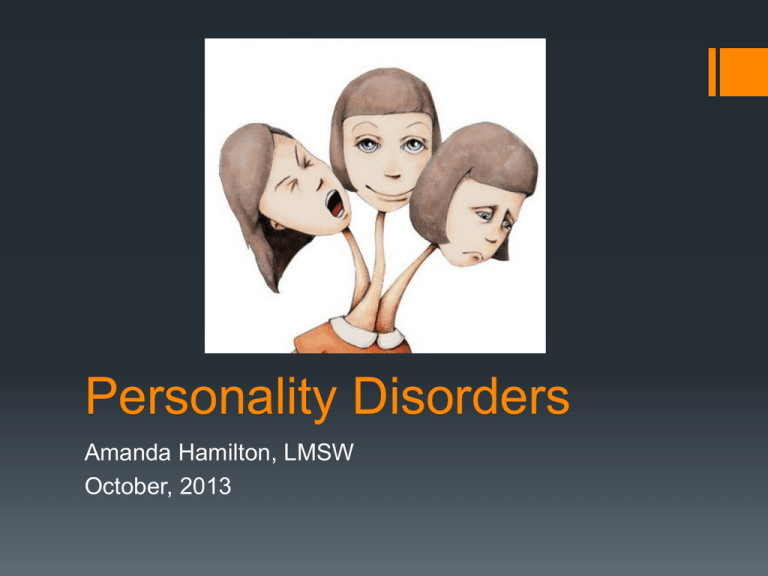
Personality Disorders Amanda Hamilton, LMSW October, 2013 Table of Contents Definition of Personality Disorders Statistical Data Indicators of a Personality Disorder DSM IV vs DSM V Overview of Each Personality Disorder Treatment of Personality Disorders Q&A Personality A set of enduring behavioral and mental traits that distinguish Human beings. Definition of Personality Disorders Classes of social disorders characterized by enduring maladaptive patterns of behavior, cognition and inner experience, exhibited across many contexts and deviating markedly from those accepted by the individual's culture. Patterns of behavior develop early, are inflexible and are associated with significant distress or disability. Patterns of behavior impact at least 2 of 4 areas: Cognition: Ways of perceiving and interpreting self, other people and events. Affectivity: The range, intensity, lability, and appropriateness of emotional response. Interpersonal functioning Impulse control Statistics Personality disorders are diagnosed in 40-60% of psychiatric patients. 9.1% of adults are estimated to have a personality disorder. 39% of adults with personality disorders are estimated to be receiving treatment. 2-3% have the more common personality disorders: Schizotypal, Antisocial, Borderline, Histrionic. 0.5-1% have the least common personality disorders: Narcissistic and Avoidant. Tasman, Allan et al (2008). Psychiatry. Third Edition. John Wiley & Sons, Ltd. Statistics: Gender Prevalence Disorder Gender Prevalence Paranoid Personality Disorder Male Schizoid Personality Disorder Male Schizotypal Personality Disorder Male Antisocial Personality Disorder Male Borderline Personality Disorder Female Histrionic Personality Disorder Female Narissistic Personality Disorder Male Avoidant Personality Disorder Equal Dependent Personality Disorder Female Obsessive-Compulsive Personality Disorder Male Tasman, Allan et al (2008). Psychiatry. Third Edition. John Wiley & Sons, Ltd. Diagnosing Generally, must individual must be 18 years or older. Rule-out other causes for the behavior: Substance abuse, organic causes, other diagnoses or medical conditions. Behaviors are present in a variety of contexts in the individuals life. DSM IV vs DSM V DSM IV has Personality Disorders on Axis 2. DSM V combines Axis 1-3. DSM V shows ICD -9 and ICD-10 coding. ICD-10 is to be implemented beginning October 1, 2014. Clusters Personality disorders are categorized into three clusters that differentiate them by type. Cluster A: Odd or eccentric disorders (Paranoid, Schizoid, Schizotypal) Cluster B: Dramatic, emotional, or erratic disorders (Antisocial, Borderline, Histrionic, Narcissistic) Cluster C: Anxious or fearful disorders (Avoidant, Dependent, Obsessive-compulsive) Cluster A Odd or eccentric disorders (Paranoid, Schizoid, Schizotypal) May be first apparent in childhood and adolescence (Attract teasing): Poor peer relationships, social anxiety, underachievement, peculiar thoughts and language Disorder Paranoid Personality Disorder Schizoid Personality Disorder Schizotypal Personality Disorder ICD-9 301.0 ICD-10 F60.0 301.20 F60.1 301.22 F21 Cluster B Dramatic, emotional, or erratic disorders (Antisocial, Borderline, Histrionic, Narcissistic) Severity may lessen as the person gets to age 30-40 (Particularly with Borderline and Antisocial PD) Disorder Antisocial Personality Disorder Borderline Personality Disorder Histrionic ICD-9 ICD-10 301.7 F60.2 301.83 F60.3 Personality 301.50 F60.4 301.81 F60.81 Disorder Narissistic Personality Disorder Cluster C Cluster C: Anxious or fearful disorders (Avoidant, Dependent, Obsessive-compulsive) May show symptoms in infancy and childhood, but make sure it’s not developmentally appropriate particularly with Dependent PD. Disorder ICD-9 ICD-10 Avoidant Personality 301.82 Disorder F60.6 301.6 Dependent Personality Disorder F60.7 301.4 ObsessiveCompulsive Personality Disorder F60.5 Cluster A: Paranoid Pervasive distrust and suspiciousness of others such that their motives are interpreted as malevolent, beginning by early adulthood and present in a variety of contexts as indicated by four or more of the following: Cluster A: Paranoid Suspects that others are exploiting, harming, or deceiving them. Preoccupied with doubts about loyalty or trustworthiness of others. Reluctant to confide in others because of fear that information will be used against them. Reads hidden meanings into remarks or events. Cluster A: Paranoid Persistently bears grudges. Perceives attacks on his or her character and is quick to react or counterattack. Recurrent suspicions regarding fidelity of spouse or partner. Cluster A: Paranoid Treatment Reduced levels of trust can hinder rapport building with patient Psychotherapy Antidepressants Antipsychotics Anti-anxiety medications Cluster A: Schizoid Pervasive pattern of detachment from social relationships and restricted range of expression of emotions in interpersonal settings, beginning by early adulthood and present in a variety of contexts as indicated by four or more of the following: Cluster A: Schizoid Neither desires or enjoys close relationships, including being part of a family. Chooses solitary activities. Little interest in having sexual experiences. Takes pleasure in few activities. Cluster A: Schizoid Lacks close friends or confidants other than immediate family. Indifferent to praise or criticism of others. Shows emotional coldness, detachment, or flat affect. Cluster A: Schizoid Treatment Atypical antipsychotics (Risperidone, etc) are commonly used to treat the negative symptoms such as anhedonia and blunted affect Anti-anxiety medications Antidepressants Therapy Socialization groups Cluster A: Schizotypal Pervasive pattern of social and interpersonal deficits marked by acute discomfort with and reduced capacity for close relationships. Cognitive or perceptual distortions and eccentricities of behavior, beginning by early adulthood and present in a variety of contexts, as indicated by five or more of the following: Cluster A: Schizotypal Ideas of reference. Odd beliefs or magical thinking that influence behavior. Usual perceptual experiences. Suspiciousness or paranoid ideation. Cluster A: Schizotypal Inappropriate or constricted affect. Behavior or appearance that is odd. Lacks close friends or confidants other than immediate family. Excessive social anxiety. Cluster A: Schizotypal Treatment Atypical antipsychotics Anti-anxiety medications Antidepressants Therapy Group therapy is recommended only if well structured and supportive. However, may have a lot of difficulty in groups even with high structure if paranoia is high. Cluster B: Antisocial Pervasive pattern of disregard for and the violation of the rights of others occurring since age 15 years, as indicated by three or more of the following: Cluster B: Antisocial Failure to conform to social norms with respect to lawful behaviors. Deceitfulness, as indicated by repeated lying, use of aliases, or conning others for personal profit or pleasure. Impulsivity or failure to plan ahead. Irritability and aggressiveness. Cluster B: Antisocial Irritability and aggressiveness. Reckless disregard for safety of others. Consistent irresponsibility. Lack of remorse. Cluster B: Antisocial Treatment Difficult to treat due to lack of remorse. Some studies have shown outpatient treatment not likely to be successful and often has to be forced by parole. Residential programs that offer carefully controlled environments and supervision along with peer confrontation have been recommended. Schema Therapy is being investigated as a treatment modality. Cluster B: Borderline Pervasive pattern of instability of interpersonal relationships, self-image, and affects and marked impulsivity beginning by early adulthood. Present in a variety of contexts, as indicated by 5 or more of the following: Cluster B: Borderline Frantic efforts to avoid real or imagined abandonment. Pattern of unstable or intense interpersonal relationships. Identity disturbance. Impulsivity in at least two areas that are potentially self-damaging. Cluster B: Borderline Recurrent suicidal behavior or selfmutilation. Instability due to marked reactivity of mood. Chronic feelings of emptiness. Inappropriate intense anger or problems controlling anger. Stress related paranoid ideation or severe dissociative symptoms. Cluster B: Borderline Treatment Long term therapy (Mentalization Based Treatment, Transference Focused Treatment, Dialectical Behavior Treatment, Schema Therapy) Medications (Antipsychotics, Antidepressants, Anti-anxiety) Mindfulness meditation Acute services and hospitalizations Cluster B: Histrionic Pervasive pattern of excessive emotionality and attention seeking, beginning by early adulthood and present in a variety of contexts as indicated by 5 or more of the following: Cluster B: Histrionic Uncomfortable in situations which they are not the center of attention. Inappropriate sexually seductive or provocative behavior. Rapidly shifting and shallow expression of emotions. Usage of physical appearance to draw attention. Cluster B: Histrionic Speech that is excessively impressionistic and lacking detail. Self-dramatization, theatricality, and exaggerated expression of emotion. Easily influenced. Considers relationships more intimate than they really are. Cluster B: Histrionic Treatment Treatment often prompted by depression associated with dissolved relationship. Antidepressants for treatment of depression. Cognitive therapy. Cluster B: Narcissistic Pervasive pattern of grandiosity, need for admiration, and lack of empathy, beginning by early adulthood and present in a variety of contexts, as indicated by five or more of the following: Cluster B: Narcissistic Grandiose sense of self-importance. Preoccupied with fantasies of unlimited success, power, brilliance, beauty, and ideal love. Belief he or she is special and should only associate with or be understood by highstatus people. Requires excessive admiration. Cluster B: Narcissistic Sense of entitlement. Interpersonally exploitive. Lacks empathy. Envious of others or feels people are envious of them. Shows arrogant, haughty behaviors, or attitudes. Cluster B: Narcissistic Treatment Individual may resist therapy or not go due to unconscious fears of exposure or inadequecy Schema Therapy Medication if needed Cluster C: Avoidant Pervasive pattern of social inhibition, feelings of inadequacy, and hypersensitivity to negative evaluation, beginning by early adulthood and present in a variety of contexts, as indicated by four or more of the following: Cluster C: Avoidant Avoids occupational activities that involve significant personal contact, because of fears of criticism, disapproval, or rejection. Unwilling to get involved with people unless certain of being liked. Shows restraint within intimate relationships because of the fear of being shamed or ridiculed. Preoccupied with being criticized or rejected in social situations. Cluster C: Avoidant Inhibited in new interpersonal situations because of feelings of inadequacy. Views self as socially inept, personally unappealing, or inferior to others. Unusually reluctant to take personal risks or to engage in any new activities because they may prove embarrassing. Cluster C: Avoidant Treatment Social skills training Cognitive Therapy Group Therapy Barrier to therapy is getting gaining individuals trust and keeping it Cluster C: Dependent Pervasive and excessive need to be taken care of that leads to submissive and clinging behavior and fears of separation, beginning by early adulthood and present in a variety of contexts, as indicated by five or more of the following: Cluster C: Dependent Difficulty with making everyday decisions without an excessive amount of advice and reassurance from others. Needs others to assume responsibility for most major areas of his or her life. Difficulty expressing disagreement with others because of fear of loss of support or approval. Difficulty initiating projects or doing things on his or her own. Cluster C: Dependent Goes to excessive lengths to obtain nurturance and support from others, to the point of volunteering to do things that are unpleasant. Feels uncomfortable or helpless when alone because of exaggerated fears of being able to care for themselves. Urgently seeks another relationship as a source of care and support when a close relationship ends. Preoccupied with fears of being left to take care of himself or herself. Cluster C: Dependent Treatment Therapy Medication used with therapy Cluster C: Obsessive-Compulsive Pervasive pattern of preoccupation with orderliness, perfectionism, and interpersonal control, at the expense of flexibility, openness, and efficiency, beginning by early adulthood and present in a variety of contexts, as indicated by four or more of the following: Cluster C: Obsessive-Compulsive Preoccupied with details, rules, lists, order, organization, or schedules to the point major activity is lost. Shows perfectionism that interferes with task completion. Excessively devoted to work and productivity to the exclusion of leisure activities and friendship. Unable to discard worn-out or worthless objects even when they have no sentimental value. Cluster C: Obsessive-Compulsive Reluctant to delegate tasks or to work with others unless they submit to exactly his or her way of doing things. Adopts miserly spending style towards self and others. Money is viewed as something to be hoarded. Shows rigity and stubbornness. Cluster C: Obsessive-Compulsive Treatment Cognitive-Behavioral Therapy Self-help Treatment may be complicated if person does not feel they have a problem or that behaviors shouldn’t be changed Medication can be used with therapy Treatment of Personality Disorders Treatment varies on personality disorder type Each disorder has it’s own barriers to being able to treat the individual Be aware of countertransference (Redirection of therapists feelings towards the individual) Refer individual out when needed. References American Psychiatric Association (2013). Diagnostic and Statistical Manual of Mental Disorders (Fifth ed.). Arlington, VA: American Psychiatric Publishing. pp. 646–649. Lenzenweger MF, Lane MC, Loranger AW, Kessler RC (2007). DSM-IV personality disorders in the National Comorbidity Survey Replication. Biological Psychiatry, 62(6), 553-564. Tasman, Allan et al (2008). Psychiatry. Third Edition. John Wiley & Sons, Ltd. Kendler KS, Czajkowski N, Tambs K et al. (2006). "Dimensional representations of DSM-IV cluster A personality disorders in a population-based sample of Norwegian twins: a multivariate study". Psychological Medicine 36 (11): 1583– 91 References Derefinko, Karen J.; Thomas A. Widiger (2008). "Antisocial Personality Disorder". The Medical Basis of Psychiatry American Psychiatric Association, 2013 Question and Answer
